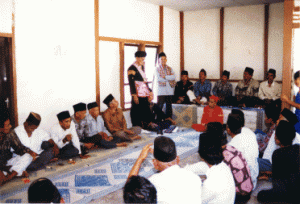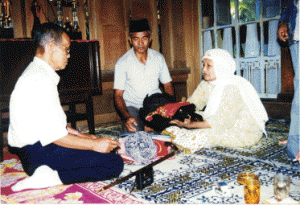Life Among the Minangkabau of Indonesia
Peggy Reeves Sanday
Inauguration of the Titled Male Leader
Each clan has a small number of titles conferred on certain men who are carefully selected. There are strict criteria specifying a man’s eligibility for the title. Most importantly, the man must be a direct matrilineal descendent of the man from whom he inherits the title. He must be “sapayung, sapatogak,” which means under the same genealogical umbrella, sharing the same immediate maternal ancestors. Because of the importance of proving exact genealogical ties for purposes of inheriting land or titles, all families keep an official genealogical chart.
The title confers considerable responsibility in terms of the management of internal clan affairs with respect to ancestral land. These affairs are conducted by a man only with the agreement of his close female relatives. Should there be internal clan disputes over his conduct, women can see to it that the matter is discussed in the village meeting house (“balai adat.”) Because men in this position could abuse clan interests for their own profit, the man chosen to receive a title must display more than the correct genealogical link. He must be deemed honest, truthful, straightforward, and strong enough to uphold the rules of customary (adat) law. A man who breaks this law, for example by selling land without the appropriate agreement from all his female relatives, will be divested of his title by the council of male leaders. It is also believed that such a man can be struck dead by the higher power that oversees the proper observance of adat law. These are not empty sanctions. I have observed situations in which one man lost his title and another met with sudden death because he sold some ancestral property for his own gain.
Since there are few titles in each clan and the title is conferred for a lifetime, the inauguration ceremony is a rare event. The ceremony depicted in these pictures occurred during my stay in Eggi’s village in the summer of l996. Tragically, the man shown in these pictures died a week after the events pictured. Even as the whole village grieved for him there were rumors that he had broken adat laws in his haste to take over the title. Although there was never any direct proof of this possibility, the existence of the rumor gives voice to the power of adat.
As is the custom, candidates for the title vacated by his death were discussed on the day of his burial at the grave site. Another ceremony like the one I observed was repeated a few weeks later in the same house. The new candidate was grand nephew (sister’s daughter’s son) to the deceased. After elaborate festivities in which a buffalo was slaughtered and the whole village invited to celebrate the event, this candidate was officially installed as the new titled male leader.
On the day of his inauguration, close relatives gathered in his sister’s house where he was presented with the clothes and insignia of office (hat and kris) by a woman from his father’s matrilineal clan. As at weddings, the father’s family provides the clothes and plays a central role in the conduct of this ceremony.
The head cloth (called “destar), the badge of his titled position, is conferred on the candidate by the male leader appointed by the government to oversee all adat affairs in the area of Eggi’s village. In former times this role was played by a high ranking male member of the father’s family. Others claimed that this task was the job of the local head of the adat council. I often encountered such discrepancies in what people did and said.
After the ceremony the family poses for the all important group photo with their new leader. The umbrella is part of the insignia of office, a sign of royalty in the past.
The whole family and several trucks carrying well-wishers, mostly women, make the short trip to the head village where the candidate will sit among male leaders from the villages that make up what was formerly considered an independent social entity. Eggi’s village is one of four villages that forms part of a larger unit called “nagari.” The oldest village is called the head village. It is the source from which people migrated to form the other villages. Here the candidate if officially accepted by adat representatives from the nagari. The ceremony is long, lasting several hours. In the past it probably last the whole night. Many stylized speeches are given telling the candidate how he must behave. He then pays each of the gathered men a set amount of money. At the end, he stands with the man beside him and gives a speech. This concludes the ceremony. A few days later, he died in a motorcycle accident while travelling to get the papers signed making his ascension to office official in the eyes of the government. He was succeeded by his sister’s daughter’s son.

